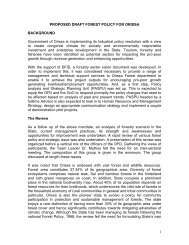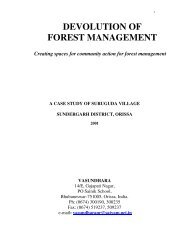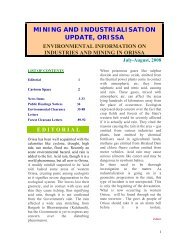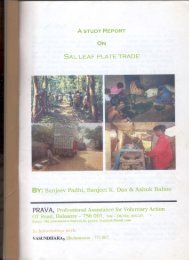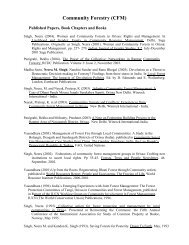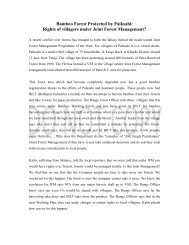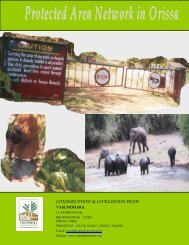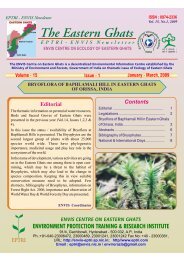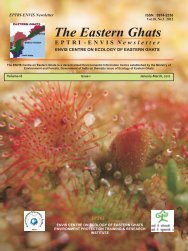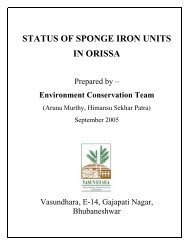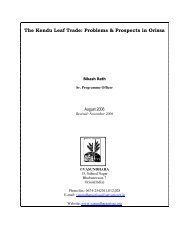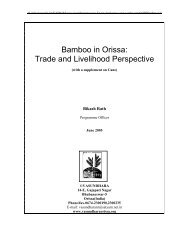Impact of NTFP ban on the lives and livelihood of the ... - Vasundhara
Impact of NTFP ban on the lives and livelihood of the ... - Vasundhara
Impact of NTFP ban on the lives and livelihood of the ... - Vasundhara
You also want an ePaper? Increase the reach of your titles
YUMPU automatically turns print PDFs into web optimized ePapers that Google loves.
sanctuary area. Dhaniram majhi, who previously worked as a phadi in <strong>on</strong>e <str<strong>on</strong>g>of</str<strong>on</strong>g> phadis at Katingpanirevealed that each pers<strong>on</strong> involved in Kendu leaf plucking earned around 5000 Rs <strong>on</strong> an averageeach year .It appeared to be a dynamic process that involved interacti<strong>on</strong>s at various levels forec<strong>on</strong>omic transacti<strong>on</strong>s. The Tribal people <str<strong>on</strong>g>of</str<strong>on</strong>g> <strong>the</strong> area use timbers for c<strong>on</strong>structi<strong>on</strong> <str<strong>on</strong>g>of</str<strong>on</strong>g> <strong>the</strong>ir houses,firewood for cooking, bamboos for fencing, ro<str<strong>on</strong>g>of</str<strong>on</strong>g>ing <strong>and</strong> making small h<strong>and</strong>icraft items <strong>and</strong> grassesfor thatching <strong>the</strong>ir ro<str<strong>on</strong>g>of</str<strong>on</strong>g>.Apart from <strong>the</strong> heavy dependence <str<strong>on</strong>g>of</str<strong>on</strong>g> people <strong>on</strong> forest produces, majority <str<strong>on</strong>g>of</str<strong>on</strong>g> people in fourpanchayats have been cultivating <strong>on</strong> forestl<strong>and</strong>s since last five-six decades. Cultivati<strong>on</strong> <strong>on</strong> <strong>the</strong>seencroached l<strong>and</strong>s has been supplementing <strong>the</strong> <strong>livelihood</strong> <str<strong>on</strong>g>of</str<strong>on</strong>g> <strong>the</strong> people, as <strong>the</strong> magnitude <str<strong>on</strong>g>of</str<strong>on</strong>g> revenuel<strong>and</strong> possessed by people is very less. Sample data collecti<strong>on</strong> in some <str<strong>on</strong>g>of</str<strong>on</strong>g> <strong>the</strong> selected villages <str<strong>on</strong>g>of</str<strong>on</strong>g> fourpanchayats namely Sunabeda, Kermeli, Bharuamunda <strong>and</strong> Soseng depicts magnitude <str<strong>on</strong>g>of</str<strong>on</strong>g> forestl<strong>and</strong>ssince last four decades.Sl No. Gram Panchayat Name <str<strong>on</strong>g>of</str<strong>on</strong>g> <strong>the</strong> village Total No. OfHouse holdsNo. <str<strong>on</strong>g>of</str<strong>on</strong>g> householdsencroachedforest l<strong>and</strong>sTotal l<strong>and</strong>encroached1 Bharuamunda Bharuamunda 154 37 74.962 Chitidora 36 35 69.93 Katingpani 102 77 181.544 Kermeli Gola<str<strong>on</strong>g>ban</str<strong>on</strong>g>dha 92 39 63.735 Kankermanji 108 77 223.566 Pethiapali 79 60 196.787 Sunabeda Shi<str<strong>on</strong>g>ban</str<strong>on</strong>g>arayanpur 16 16 408 Jamga<strong>on</strong> 83 67 187.339 Tlabela 20 3 1110 Jhallarama 34 34 155.2611 Soseng Rupiam 54 53 318.1512 Deosil 53 48 222.513 Adar 66 57 306.2414 Soseng 127 74 210.31Bhawsil 45 30 137.67(Source: Survey C<strong>on</strong>ducted by Local NGO, VISWAS)Even during erstwhile Zamindari system <str<strong>on</strong>g>of</str<strong>on</strong>g> Khariar, <strong>the</strong> Tribal had access to some un prohibitedspecies like Dha, Amala, Karda, Salai, Arjun etc <str<strong>on</strong>g>of</str<strong>on</strong>g> two feet girth. There were provisi<strong>on</strong>s <str<strong>on</strong>g>of</str<strong>on</strong>g> royaltyfor accessing Tree species <str<strong>on</strong>g>of</str<strong>on</strong>g> some prohibited species like Saguan, Bija, Sisoo, Sal, B<strong>and</strong>han, <strong>and</strong>Achu <str<strong>on</strong>g>of</str<strong>on</strong>g> more than two feet girth. Details <str<strong>on</strong>g>of</str<strong>on</strong>g> <strong>the</strong>se rights <strong>and</strong> c<strong>on</strong>cessi<strong>on</strong>s enjoyed by <strong>the</strong> local Tribalover forests <strong>and</strong> forest produces are menti<strong>on</strong>ed in <strong>the</strong> “Wazib-ul-urz” <str<strong>on</strong>g>of</str<strong>on</strong>g> <strong>the</strong> Ex-Zamindari system(Life in Sunabera Plateau by N.Pattanaik, P.K.Mohanty <strong>and</strong> T.Sahoo, Page 29). Analysis <str<strong>on</strong>g>of</str<strong>on</strong>g> <strong>the</strong>serights <strong>and</strong> c<strong>on</strong>cessi<strong>on</strong>s also reveal that people had <strong>the</strong> access to fruit bearing trees despite <strong>the</strong>ultimate right <str<strong>on</strong>g>of</str<strong>on</strong>g> Zamindar over <strong>the</strong> trees. Only while selling fruits derived from such trees <strong>the</strong>y weresupposed to sell fruits to c<strong>on</strong>tractors appointed by Zamindar. Tribal staying <strong>the</strong>re also had <strong>the</strong> rightto use small <strong>and</strong> miscellaneous trees <str<strong>on</strong>g>of</str<strong>on</strong>g> girth up to 2 feet. It is quite obvious that <strong>the</strong> erstwhileZamindari system was aware <str<strong>on</strong>g>of</str<strong>on</strong>g> people’s dependence <strong>on</strong> <strong>the</strong>ir natural resources <strong>and</strong> had made29



